
A mysterious Russian satellite has created a large cloud of debris after breaking apart in orbit in early January, posing a potential problem for years to come. According to the US Space Force’s 18th Defense Squadron (SDS), which tracks artificial objects in space, the event created at least 85 separate pieces of junk that will now stay in orbit for a significant amount of time.
The satellite itself was Kosmos 2499, a Russian craft that has no known purpose. The cause of the disintegration is also a mystery, with neither the SDS nor Roskosmos commenting on how the event may have occurred.
Kosmos 2499 was an entirely unknown satellite, launched from a Russian Rockot launch vehicle alongside three Rodnik-S satellites, which are used for military communications, in 2014. It was originally classified as a piece of space debris by the US until it started maneuvering in ways that debris shouldn’t, indicating it was an intentional orbiter placed there by Russia.
In fact, Kosmos 2499 moved in ways other satellites generally didn’t, using powered maneuvers to close in on rocket stages and other orbiting objects, leading to wild speculation about its use – some thought it was a maintenance satellite to maintain others, while some even proposed it was a new type of anti-satellite weapon.
Expectedly, the US military kept a close eye on Kosmos 2499.
Writing in a blog post to his website RussianSpaceWeb.com, Anatoly Zak wrote:
“The US military was now rechecking orbital parameters of the mysterious satellite three or four times a day!”
Rumors surrounding its purpose were addressed by Roscosmos many years ago, stating that the satellite was for “peaceful purposes including unspecified research by educational institutions”. It had supposedly completed its mission in 2014. However, in the years following, Kosmos 2499 continued to make targeted maneuvres towards other craft, which is not typical of a supposedly irrelevant satellite.
Regardless of its function, Kosmos 2499 will not be making any more maneuvers after disintegrating, but it does leave a new challenge in its wake. The debris cloud at that altitude, which is thought to be 1,169 kilometers (729 miles), will remain orbiting the earth for years to come, adding to the huge cloud of debris that surrounds the earth already.
Such events continue to pollute the crowded environment, and all space agencies should be constantly working to minimize this risk. For Kosmos 2499, any efforts will now be too late.
Source Link: A Mysterious Russian Satellite Has Disintegrated In Orbit, Concerning Space Agencies